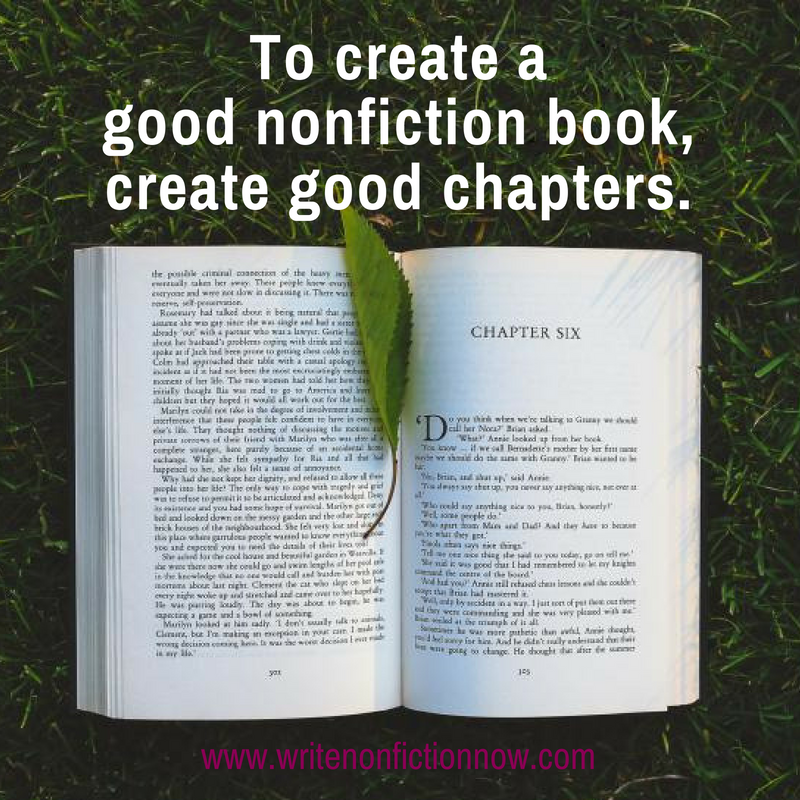Wednesday, July 11, 2018

When you read a book, you may take the structure for granted. But a nonfiction book’s chapters create a structure and a map. They provide the foundation for a good read. In this guest post, book editor
C.K. Bush (
@theladyck) delves deeply into the importance of chapters and how to create them in a way that makes readers want to read until the end.
Most people don’t give a lot of thought to chapters. It’s easy to overlook them as just dividing lines in a book-length piece of writing.
Avoid that mistake.
In fact, chapters are an essential narrative tool that have a major impact on the quality of your book. They present ideas and create suspense. They pace a narrative and focus a reader’s attention on the details that matter. Therefore, creating good, useful chapters is an integral part of the art form of nonfiction writing that all aspiring writers should aim to master.
Chapters are an essential narrative tool that have a major impact on the quality of your book. Click To Tweet
A Chapter Needs a Thesis
Each chapter should have a clear purpose designed into it. Ideally, your chapters should be planned out from the beginning. Think of them as longer versions of paragraphs in your traditional high-school essay, each with their own topic but building toward a larger argument.
Your book itself always has a central argument–even if that argument is something as simple as “life is easier when you clean your bedroom.” (If you can’t figure out the one-sentence main argument of your book, take a step back to work that out first.) Additionally, though, each chapter should have its own individual thesis to hold it together–one that connects back to book’s central argument. This thesis is the spiritual equivalent of a topic sentence in one of those high school essays. However, putting it plainly as the chapter opener would be too abrupt and not artful. It’s a one-sentence description (in your mind) of what the chapter is about.
Going back to our fictional book about life being easier when you clean your bedroom, you chapters might be described this way:
- Chapter one is about the importance of realizing why your bedroom is so essential to well-being.
- Chapter two is about how to assess what needs to be cleaned.
- Chapter three is about tackling the closet.
- …and so on.
You can see that these chapters each have their own thesis but all support a larger thesis of how cleaning your bedroom improves your life.
These rules obviously work for discursive nonfiction, but they work for narrative nonfiction as well. Even if you are following a temporally-based plot, there is likely something on each point along the way to which you’d like to draw attention. That, then, becomes the ‘”topic” or “point” of your chapter.
Each chapter should have a clear purpose designed into it.Click To Tweet
Chapters Create the Pace
Too many chapters relative to the length of a book provides me—the manuscript editor—with a clear sign that an author has not thought through the book’s structure well enough. This signals that the book is going to move too slowly. Each chapter creates a significant break in the story being told, so take care to make sure that each chapter break is a meaningful pause. No one likes being on a bus that stops every two blocks. The same is true for readers trying to get to the end of a book who keep getting stopped in the middle of ideas for arbitrary pauses.
Generally, I think a chapter should be at least 10,000 to 15,000 words long. One exception to this rule is a book clearly designed around small or short chapters, such as one with lots of brief profiles, a travel guide, or a cookbook. Otherwise, for changes of ideas within a chapter that don’t elevate to the level of a true meaningful pause, use line breaks or horizontal dividers.
Conversely, having too long chapters can be overwhelming to a reader. Long chapters are the equivalent of being on a bus that is clearly barreling past stops it is supposed to make. If you have multiple big ideas in one chapter, and it’s longer than 15,000 words, consider breaking it up. The chapter is a great way to regulate the pace of the book to make the reading experience enjoyable for your audience.
The book chapters serve as a vehicle to let readers know why the book’s argument matters.Click To Tweet
Where Are We Going and Why Should We Care?
In addition to serving as the building blocks of the overall story you’re trying to tell, the book chapters serve as a vehicle to let readers know why the book’s argument matters. Each chapter should end and begin with stories, examples, or analysis that ties back (even subtly) to the main argument and its implications. In this way, the chapters hold the reader’s attention on the real aims of the book throughout. They also provide time for these ideas to sink in. It’s never good to wade through an entire book only finding out in the final few pages why you bothered.
For all of these reasons, chapters are crucial components of a book. Craft them with care and deliberateness, you’ll end up with a better book because of it.
How do you create your chapters? Tell me in a comment below.
About the Author
 C.K. Bush
C.K. Bush is a nonfiction editor and writer. She lives in New York City.
Photo copyright: 85Fifteen on Unsplash
The post
Why Your Nonfiction Book Chapters are So Important appeared first on
Write Nonfiction NOW!.
Nina Amir, the bestselling author of How to Blog a Book and The Author Training Manual, is a speaker, a blogger, and an author, book, blog-to-book, and high-performance coach. Known as the Inspiration to Creation Coach, she helps creative people combine their passion and purpose so they move from idea to inspired action and positively and meaningfully impact the world as writers, bloggers, authorpreneurs, and blogpreneurs. Some of Nina’s clients have sold 300,000+ copies of their books, landed deals with major publishing houses and created thriving businesses around their books. She is the founder of National Nonfiction Writing Month, National Book Blogging Month, and the Nonfiction Writers’ University. As a hybrid author she has published 19 books and had as many as four books on the Amazon Top 100 list at the same time. Her most recent book is called Creative Visualization for Writers, and tomorrow her 19th book will be released, The Write Nonfiction NOW! Guide to Creativity and Flow. Find all her books at booksbyninaamir.com or find out more about her at ninaamir.com.